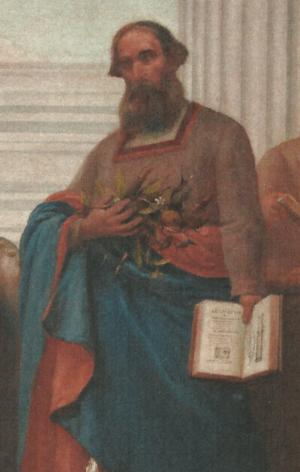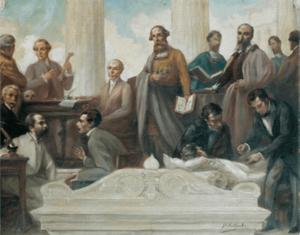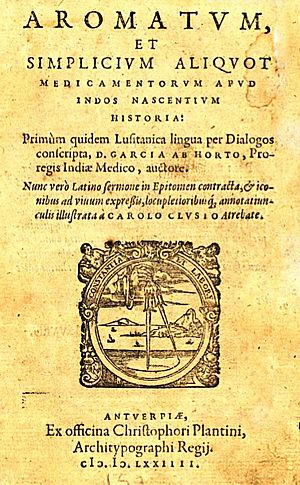Garcia de Orta facts for kids
Quick facts for kids
Garcia de Orta
|
|
|---|---|

Garcia de Orta, from a 1905 painting by Veloso Salgado (NOVA Medical School, Lisbon)
|
|
| Born | 1501 or 1502 Castelo de Vide, Kingdom of Portugal
|
| Died | 1568 |
| Occupation | Physician and naturalist |
| Signature | |
 |
|
Garcia de Orta (or Garcia d'Orta) (1501 – 1568) was a Portuguese doctor, plant expert, and scientist. He mostly worked in Goa and Bombay in Portuguese India.
He was one of the first people to study medicines from plants in hot countries. He also explored how different cultures used plants for healing. Garcia de Orta used a scientific approach to find and use herbal medicines. He didn't just rely on old ideas.
His most famous book is Colóquios dos simples e drogas da India. This book is about simple herbs and medicines. It was published in 1563 and is the earliest book about India's medicinal and economic plants. Another scientist, Carolus Clusius, translated it into Latin. This made it a very important book for studying medicinal plants.
Sadly, after Garcia de Orta died, his family faced difficulties. His sister Catarina was accused of secretly practicing Judaism and was executed in 1569. Based on her confession, Garcia's remains were later dug up and burned.
Today, there are memorials in both Portugal and India that honor his important work.
Contents
Early Life and Education
Garcia de Orta was born in Castelo de Vide, Portugal, probably in 1501. His parents, Fernão da Orta and Leonor Gomes, were Spanish Jews. They had moved to Portugal to escape persecution in Spain in 1492. In Portugal, they were forced to become Christians in 1497. They were called New Christians. Some of these families secretly kept their Jewish faith.
Garcia's father sent him to university. Garcia studied medicine, arts, and philosophy in Spain at the Universities of Alcalá de Henares and Salamanca. He finished his studies and returned to Portugal in 1525.
He started practicing medicine in his hometown. From 1526, he worked in Lisbon. He became a lecturer at the university in 1532. He also became the royal doctor for John III of Portugal.
Journey to India
Garcia de Orta might have been worried about the growing power of the Portuguese Inquisition. This was a court that punished people for not following the Catholic faith. Luckily, he was able to leave Portugal. In March 1534, he sailed to Portuguese India as the Chief Physician. He was part of the fleet led by Martim Afonso de Sousa, who later became a governor.
He arrived in Goa in September 1534. He traveled with Sousa on different trips. Then, in 1538, he settled in Goa. He quickly became a very important doctor there. He was the doctor for Burhan Nizam Shah I, a ruler in India. He also served several Portuguese governors of Goa.
Garcia de Orta even owned an island called Ilha da Boa Vida ("the Island of the Good Life"), which became part of Bombay. He had a large house with a big garden there. This is where he likely kept his impressive library.
Family and Challenges
In 1543, Garcia de Orta married his wealthy cousin, Brianda de Solis. They had two daughters. In 1549, his mother and two sisters, who had been imprisoned in Lisbon, joined him in Goa.
After Garcia de Orta died, it was revealed that he had secretly continued to believe in Judaism. In 1565, a court called the Inquisition started in Goa. It began to persecute Jews, secret Jews, Hindus, and New Christians. Garcia died in 1568, before he was seriously affected by this persecution. However, his sister Catarina was arrested as a Jew that same year. She was executed in Goa in October 1569.
Garcia himself was found guilty of Judaism after his death. His remains were dug up and burned in a public ceremony in December 1580.
Garcia de Orta's Important Work
Garcia de Orta was a busy doctor, so he didn't travel much beyond India's west coast. But in the busy markets of Goa, he met spice merchants, traders, and doctors from many parts of Asia. He knew Portuguese, Spanish, Hebrew, Latin, Greek, and Arabic. His work shows he learned a lot from traditional healers in India.
He had people send him seeds and plants. He also traded in spices and valuable stones. He had his own laboratory and a garden for plants. De Orta learned from both Yunnani medicine (from the Middle East) and Ayurveda (from India). He often used European medical methods first. If they didn't work, he would try local Indian methods.
His amazing knowledge of Eastern spices and medicines is shown in his only known book. It is called Colóquios dos simples e drogas he cousas medicinais da Índia. The first edition was published in Goa in 1563. This book talks about many substances that were unknown or misunderstood in Europe at the time. For example, before his book, people thought tamarind came from a palm tree. He also wrote many details about plants and how they grow.
He was the first European to describe the symptoms of several tropical diseases in Asia, like cholera. He even performed an autopsy (an examination of a body after death) on a cholera victim. This was the first recorded autopsy in India.
In his writings, Garcia de Orta showed that he didn't just blindly follow old texts from Greek, Latin, or Arabic writers. His book, Coloquios, has 59 chapters. It is written as a conversation between de Orta and a traditional doctor named Ruano. This way of writing was common when people wanted to discuss new ideas that challenged old ones. Orta's work questioned old ideas and offered new ones. His scientific method combined careful observation and new theories.
Garcia de Orta also pointed out that Portuguese traders often didn't care about learning new things:
The Portuguese, who navigate over a greater part of the world only procure a knowledge of how best to dispose of that merchandise of what they bring here and what they shall take back. They are not desirous of knowing anything about the things in the countries they visit. If they know a product they do not learn from what tree it comes, and if they see it they do not compare it with one of our Indian trees, nor ask about its fruit or what it is like.
The first printing press in Goa started in 1556. Garcia's book was one of the first few European books ever printed in India. The first edition had many printing errors. The list of corrections was twenty pages long!
Garcia's trips to Portuguese Ceylon (now Sri Lanka) with Martim Afonso de Sousa allowed him to study Sri Lankan medicinal plants. He described plants used to treat snakebites. He also wrote about plants used in crime, like Datura, which thieves used to poison their victims.
The famous Portuguese poet Luís de Camões wrote a poem for the beginning of Garcia's book. Camões was considered Portugal's national poet. The book was dedicated to Dom Francisco Coutinho, a governor of Goa, and to his friend Martim de Sousa. Garcia wrote the book in Portuguese, not Latin, so that traders and local people could use it.
Garcia de Orta's work was later found by Carolus Clusius in 1564. Clusius translated it into Latin. He changed it from a conversation style to a summary. This Latin version was read widely across Europe and had many editions.
Books by Garcia de Orta

The first edition of Garcia de Orta's book was in Portuguese. It was published in Goa in 1563 and had 217 pages. Only about six copies of this first edition are thought to exist today. A second Portuguese version was published in Lisbon in 1872.
Carolus Clusius created a shorter Latin version in 1567. This version had many more editions later on. An Italian translation of the Latin version was made in 1576. A Spanish version, which included parts of Clusius's work, was published in 1578.
- Coloquios dos Simples e Drogas da India. Band 1 . Imprensa nacional, Lisboa 1891 (Digital edition by the University and State Library Düsseldorf)
- Coloquios dos Simples e Drogas da India. Band 2 . Imprensa nacional, Lisboa 1892 (Digital edition by the University and State Library Düsseldorf)
- Histoire des drogues, espiceries, et de certains medicamens simples, qui naissent és Indes et en l'Amerique : divisé en deux parties: La première comprise en 4 livres: Les deux premiers de Garcie Du Jardin, le troisième de Christophle de La Coste, et le quatrième de l'histoire du baulme, adjousteée de nouveau en ceste 2. éd.: où il est prouvé, que nous avons le vray baulme d'Arabie, contre l'opinion des anciens et modernes ; la seconde composée de deux livres de maistre Nicolas Monard traictant de ce qui nous est apporté de l'Amerique.... Lyon : Pillehotte, 1619. (Digital edition of the University and State Library Düsseldorf.)
Legacy and Recognition
Garcia de Orta's work influenced many later books about plants and botany. These include works by Juan Fragoso, Nicolas Monardes, Hendrik van Rheede, and Jacobus Bontius.
Several places are named in his honor:
- The "Jardim Garcia de Orta," a public garden in Lisbon.
- The "Escola Secundária Garcia de Orta" high school in Porto.
- The "Hospital Garcia de Orta" in Almada.
In Goa, the municipal garden in the capital city of Panjim is named "Garcia de Orta." It was built in 1855 and is located near the main city square.
Portugal released a postal stamp of Garcia de Orta in 1963. In 1971, his picture was on the 20 Escudos bank note.
Name Variations
Garcia de Orta's name was sometimes changed to "Garcias ab Horto" in Latin works. In some French writings, his name was translated as "de la Huerta" and "Dujardin."
See also
 In Spanish: Garcia de Orta para niños
In Spanish: Garcia de Orta para niños




